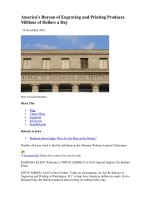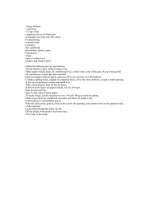Procedure to make a money bill
Bạn đang xem bản rút gọn của tài liệu. Xem và tải ngay bản đầy đủ của tài liệu tại đây (99.27 KB, 4 trang )
America’s Bureau of Engraving and Printing Produces
Millions of Dollars a Day
14 November 2010
Photo: Getty Images/iStockphoto
Share This
• Digg
• Yahoo! Buzz
• Facebook
• del.icio.us
• StumbleUpon
Related Articles
• Banknote Knowledge: Who Are the Men on the Money?
Double-click any word to find the definition in the Merriam-Webster Learner's Dictionary
Or download MP3 (Right-click or option-click and save link)
BARBARA KLEIN: Welcome to THIS IS AMERICA in VOA Special English. I'm Barbara Klein.
STEVE EMBER: And I’m Steve Ember. Today on our program, we visit the Bureau of Engraving
and Printing in Washington, D.C. to hear how American dollars are made. In two thousand nine,
the Bureau produced about twenty-six million bills a day.
Producing money requires both artistic and technological skills. Dollar bills are made so that they
are interesting to look at but very hard to copy. In total, there are sixty-five separate steps required
to make a dollar bill.
(MUSIC)
BARBARA KLEIN: Guided tours of the Bureau of Engraving and Printing are a popular activity
for visitors to Washington, D.C. These trips are a good way to learn new and interesting facts about
the history of money and its complex production methods. It is also exciting to stand in a room with
millions of dollars flying through machines.
TOUR GUIDE: "All right, ladies and gentlemen, once again welcome to the Bureau of Engraving
and Printing. And this is where the color of money begins. The money making process begins when
a yearly order sent by the Federal Reserve Board. That order will then be divided in half. Half will
be done here in Washington, D.C. and the other half will be done in Fort Worth, Texas.”
STEVE EMBER: Next, the Bureau orders special paper from the Crane Paper Company in the state
of Massachusetts. The paper is actually cloth since it is seventy-five percent cotton and twenty-five
percent linen.
This paper is made so that it can last a long time. And, it is made with details that make it hard to
copy. For example, bills contain security threads. These narrow pieces of plastic are inside the
paper and run along the width of the bill. This special paper is also made with very small blue and
red fibers. Both of these designs make it very hard to copy.
BARBARA KLEIN: The first step in production is called intaglio printing. This is done on high-
speed presses using printing plates onto which images have been cut. Each plate receives a layer of
ink, which gathers in the cut areas of the plate. Then, each piece of paper goes into the press to
receive the printing plate. The machine forces about twenty tons of pressure onto the printing plate
and paper. One side of a dollar bill is colored with green ink, while the other is printed in black.
Each side must dry for about forty-eight hours.
STEVE EMBER: The printing plate used in this process is created from hand-cut engravings called
master-dies. Highly skilled artists called engravers copy images on soft steel to make the dies.
There are separate dies for the different images on the bill, such as the picture of the president, the
lettering and other designs.
BARBARA KLEIN: After each master-die is copied, they are put together to make a printing plate
that has thirty-two copies of the bill being printed. A master-die can last for many years. For
example, the master-die with the picture of President Abraham Lincoln was made in the eighteen
sixties. It was used again in two thousand eight to redesign the five-dollar bill.
Next, the large printed sheets are carefully examined to make sure there are no mistakes on any of
the bills. This process used to be done by people. Now, computers do the work.
TOUR GUIDE: "OCIS is an acronym for Off-line Currency Inspection System and this is where
the money from the last phase will be inspected. Now that blue box will take a picture to size of the
sheets of the money and compare its cut, color and shape with the master image sent by the Federal
Reserve Board. It will take that picture and break it down into over one million pixels. Every single
last one has to be absolutely correct."
STEVE EMBER: In this part of production, the thirty-two bill sheets are cut into sheets of sixteen.
In the next step, a series of identifying numbers and seals are added to the bills.
TOUR GUIDE: “And this is where the money from the last phase will be put to its final state. If
you look to the left of the room, ladies and gentlemen, there is a tall machine with green ink at the
top of it. That is the machine that will print your serial numbers, Federal Reserve seal and Treasury
seal onto the money.”
BARBARA KLEIN: The serial numbers on the money tell the order that the bills were printed.
Other numbers and letters on the bill tell when the note was printed, what space on the printing
plate the bill occupied and which Reserve Bank will issue the bill.
STEVE EMBER: Once the money is printed, guillotine cutters separate the sheets into two notes,
then into individual notes. The notes are organized in “bricks,” each of which contains forty one-
hundred-note packages. The bricks then go to one of twelve Federal Reserve Districts, which then
give the money to local banks. Ninety-five percent of the bills printed each year are used to replace
money that is in circulation, or that has already been removed from circulation. The Federal
Reserve decides when to release this new money into use.
(MUSIC)
BARBARA KLEIN: You may know that America's first president, George Washington, is pictured
on the one-dollar bill. But do you know whose face is on the two, five, ten, twenty, fifty and one
hundred-dollar bills? They are, in order, President Thomas Jefferson, President Abraham Lincoln,
Treasury Secretary Alexander Hamilton, President Andrew Jackson, President Ulysses Grant and
statesman Benjamin Franklin.
STEVE EMBER: During the tour, visitors can learn many facts about money. For example, the
average life span of a one-dollar bill is twenty-one months. But a ten-dollar bill lasts only about
eighteen months. The one hundred-dollar note lasts the longest, eighty-nine months.
One popular question that visitors ask is about the two-dollar bill. This bill is not made very often.
This is because many Americans believe two-dollar bills are lucky, so they keep them. Two-dollar
bills do not have to be manufactured often because they do not become damaged quickly like other
bills.
People can send their damaged or torn bills to the Bureau of Engraving and Printing. The Bureau
will replace damaged bills with new bills. However, it is illegal to purposely damage United States
currency in any way. Anyone found guilty of damaging American money can be fined or jailed.
(MUSIC)
BARBARA KLEIN: The Bureau of Engraving and Printing first began printing money in eighteen
sixty-one. It operated in a room of the Treasury building. Two men and four women worked
together there to place seals on money that was printed in other places by private companies.
Today, the Bureau of Engraving and Printing has over two thousand employees in its two printing
centers in Washington and Texas.
STEVE EMBER: The Treasury Department continually works to change the design of bills to
make it difficult to copy. One method it uses is called microprinting. For example, what looks like
a very thin line around the edge of a picture may actually be the words “The United States of
America” in very small letters. Also, many bills now have color-shifting ink that looks like metallic
paint. In the last five years, the ten, twenty and fifty-dollar bills have been redesigned. All the bills
are mostly green. But other colors are added when they are redesigned.
BARBARA KLEIN: The most recent note to be redesigned is the one hundred-dollar bill. This is
the highest value bill currently made in the United States. More than ten years of research and
development went into its new security features. They offer a simple way to make sure that a new
one hundred-dollar note is real. For example, there is a blue ribbon woven into the front of the note.
If you tilt the note back and forth while looking at the blue ribbon, you will see bells on the note
change to hundreds as they move. When you tilt the note back and forth, the bells and the hundreds
move from side to side. If you tilt it from side to side, they move up and down.
STEVE EMBER: There is also an image of a bell inside a copper-colored inkwell on the front of
the note. Tilt the note to see the bell change from copper to green. This makes the bell seem to
appear and disappear within the inkwell. There are several other security features in the redesigned
one hundred-dollar bill.
Last month, the Federal Reserve Board announced a delay in releasing the new one-hundred dollar
notes. The Bureau of Engraving and Printing identified a problem with creasing of the paper during
printing. The new bills were supposed to be released February tenth, two thousand eleven. The
Bureau is working to solve the problem.
(MUSIC)
BARBARA KLEIN: Our program was written by Dana Demange and Shelley Gollust. Our
producer was Brianna Blake. I’m Barbara Klein.
STEVE EMBER: And I’m Steve Ember. Our programs are online with transcripts and MP3 files at
voaspecialenglish.com. And you can find us on Twitter, Facebook and YouTube at VOA Learning
English. Join us again next week for THIS IS AMERICA in VOA Special English.









